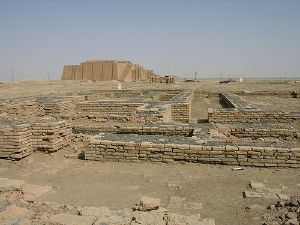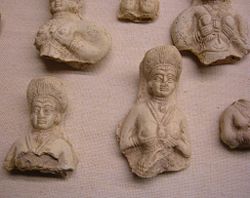Difference between revisions of "Enheduanna" - New World Encyclopedia
m |
m |
||
| Line 2: | Line 2: | ||
'''Enheduanna''' (also ''' En-hedu-Ana'''; c. [[twenty-third century B.C.E.]]) was an [[Akkad]]ian princess and high [[priestess]] of the moon god [[Nanna (Sumerian deity)|Nanna]] (Sin), who was perhaps the earliest known writer in history. Identified as a daughter of King [[Sargon I]], she was the most important religious figure of her day, and her evocative prayers, stories, and incantations devoted to the goddess [[Inanna]] were highly influential. She has been dubbed the "[[Shakespeare]] of Sumerian literature." | '''Enheduanna''' (also ''' En-hedu-Ana'''; c. [[twenty-third century B.C.E.]]) was an [[Akkad]]ian princess and high [[priestess]] of the moon god [[Nanna (Sumerian deity)|Nanna]] (Sin), who was perhaps the earliest known writer in history. Identified as a daughter of King [[Sargon I]], she was the most important religious figure of her day, and her evocative prayers, stories, and incantations devoted to the goddess [[Inanna]] were highly influential. She has been dubbed the "[[Shakespeare]] of Sumerian literature." | ||
| − | Enheduanna's writing was both sophisticated and extremely personal. She was the first known author to write in the first person, doing so in a way which displayed her unique religious sensibilities and powerful [[spirituality]]. She traveled widely, writing hymns extolling the virtues of many temples. She survived being deposed and exiled, later returning to her position as high priestess. Her influence is believed to have assisted in the merging of the Akkadian [[Ishtar]] with the Sumerian [[Inanna]]. | + | Enheduanna's writing was both sophisticated and extremely personal. She was the first known author to write in the first person, doing so in a way which displayed her unique religious sensibilities and powerful [[spirituality]]. She traveled widely, writing hymns extolling the virtues of many temples. She survived being deposed and exiled, later returning to her position as high priestess. Her writings were copied for centuries, and her influence is believed to have assisted in the merging of the Akkadian [[Ishtar]] with the Sumerian [[Inanna]]. |
==Biography== | ==Biography== | ||
Revision as of 01:45, 27 December 2008
Enheduanna (also En-hedu-Ana; c. twenty-third century B.C.E.) was an Akkadian princess and high priestess of the moon god Nanna (Sin), who was perhaps the earliest known writer in history. Identified as a daughter of King Sargon I, she was the most important religious figure of her day, and her evocative prayers, stories, and incantations devoted to the goddess Inanna were highly influential. She has been dubbed the "Shakespeare of Sumerian literature."
Enheduanna's writing was both sophisticated and extremely personal. She was the first known author to write in the first person, doing so in a way which displayed her unique religious sensibilities and powerful spirituality. She traveled widely, writing hymns extolling the virtues of many temples. She survived being deposed and exiled, later returning to her position as high priestess. Her writings were copied for centuries, and her influence is believed to have assisted in the merging of the Akkadian Ishtar with the Sumerian Inanna.
Biography
Despite living more than 4,300 years before the present, Enheduanna's historical existence is well established. Her mother was Sumerian, probably herself a priestess who hailed from southern Mesopotamia. Her father, it is generally agreed, was Sargon of Akkad, who was also the son of a priestess, perhaps a sacred harlot.
Enheduanna' name—EN.HÉ.DU.AN.NA 𒂗𒃶𒁺𒀭𒈾—means "Lady ornament of An." She served as the high priestess of the moon god Sin or Suen (also called Nanna) at the E-ana temple in Uruk. The alabaster disk which includes her image is currently on displayed at the Univeristy Museum in Philadelphia. It depicts her in a religious procession, in which she preceded by a male priest with two male attendants behind her. Enheduanna wears a ruffled dress and a brimmed turban, apparently a sign of her office.
On the back of Enheduanna's disk is an inscription recording her as the "daughter of Sargon of Akkad," the founder of the Dynasty of Akkad and the first ruler to unite northern and southern Mesopotamia, who reigned for 56 years, c. 2270–2215 B.C.E. Scholars have debated whether to take this relationship literally or symbolically. If literally true, it attests Sargon's successful policy of appointing members of his family to key posts. Moreover, there followed after Enheduanna a long tradition whereby the king appointed his daughter to the post of high priestess of Nanna, leading many scholars to conclude that Enheduanna was thus the first of such royal daughters to be appointed to this position.
Although she was the priestess of Sin/Nanna, Enheduanna's most famous work is her Nin-me-sara, devoted to the goddess Inanna/Ishtar. This is not altogether surprising, since Ishtar is often portrayed as the daughter of Nanna. In this work Enheduanna calls on Sin and Inanna for help because she has been dislodged from her position by a rebelling Sumerian king, Lugal-Ane, who, she complains, did not show proper respect for the gods. Many scholars perceive political themes woven into Enheduana's writings, motivated by her support of Sargon's imperial legacy.
Sin, tell An about Lugal-ane and my fate!... En-hedu-ana will recite a prayer to you. To you, holy Inanna I shall give free vent to my tears like sweet beer!... Lugal-ane has altered everything and has stripped An of the E-ana (temple). He has not stood in awe of the greatest deity. He has turned that temple, whose attractions were inexhaustible, whose beauty was endless, into a desolation. (Nin-me-sharra 74-90)
Her prayers to Inanna were answered with victories in battles between the Sumerians and the Akkadians. This allowed her royal nephew, Naram Sin, to successfully unite Sumer and Akkad for several years. As a result, Enheduanna was restored to her post as priestess of Nanna.
Nin-me-sara was long revered as a sacred scripture in Sumerian literature. As long as 500 years after her death, during the Babylonian era, it was used as a text copied by students learning to be scribes in the edubba, or scribal schools. More than 100 clay tablet copies of the hymn have been found, testifying to its popularity. Few Mesopotamian literary texts have boasted as many copies.
On her alabaster disk, Eh-hedu-anna styles herself the "zirru of Nanna," a mysterious term which may translated as "wife of Nanna," possibly refer to her as an embodiment of the goddess Ningal, who was Nanna's consort.
Surviving hymns
Enheduanna is known to us as the author of several early Sumerian hymns.
- Nin-me-sara, also called "The Exhaltation of Inanna," consists of 153 lines. The first 65 lines address the goddess with a list of epithets, comparing her especially to An, the supreme god of the pantheon. Enheduanna complains that she has been exiled from the temple—and asks for intercession of Nanna the goddess' father. Lines 122-135 recite divine attributes of Inanna.
- In-nin sa-gur-ra (named by incipit), 274 lines (incomplete), edited by Sjoberg (1976) using 29 fragments.
- In-nin me-hus-a, the myth of "Inanna and Ebih," first translated by Limet (1969). Her, the goddess, presented primarily as a goddess of war defeats the mountain (or country) of Ebih, which has refused to worship her properly.
- The Temple Hymns, edited by Sjoberg and Bergmann (1969): 42 hymns of varying length, extolling the virtues of various temples.
- Hymn to Ianna, a 274-line devotional hymn to the "Lady of the Great Heart."
Style and theology
Enheduanna is the first known author to write in the first person. Scribes had previously written about the king and the the gods, but never about themselves or their feelings toward their deities prior to Enheduanna.
The hymns she wrote to the goddess Inanna celebrate her individual relationship with the goddess, thereby setting down the earliest surviving verbal account of an individual's consciousness of her inner life. Historians have alo noted that Enheduanna's work displays a strong sense of a personal relationship with the divine:
- My Lady, I will proclaim your greatness in all lands and your glory!
- Your way and great deeds I will always praise! (In-nin me-hus-a 1:254-5)
- I am yours! It will always be so!
- May your heart cool off for me (In-nin me-hus-a l:246-7 & 250)
Enehduana depcits Inanna as both warlike and compassionate. "No one can oppose her murderous battle — who rivals her? No one can look at her fierce fighting, the carnage." (Hymn to Inanna:49-59) Yet, she also sees the goddess as "weeping daily your heart... knows no relaxation." (Hymn to Inanna 91-98) To Inanna she assigns wide powers in human affairs:
- To turn a man into a woman and a woman into a man are yours, Inanna.
- Desirability and arousal, goods and property are yours, Inanna.
- Gain, profit, great wealth and greater wealth are yours, Inanna.
- Gaining wealth and having success in wealth, financial loss and reduced wealth are yours, Inanna.
- Observation, choice, offering, inspection and approval are yours, Inanna.
- Assigning virility, dignity, guardian angels, protective deities and cult centres are yours, Inanna. (Hymn to Inanna 115-131)
Legacy
Enheduanna began a long tradition of Mesopotamian princesses serving a high priestesses. After her death, a hymn was devoted to her by an anonymous composer, indicating that she may even have been venerated as a deity herself. her A number of recent studies are devoted to Enheduanna. Minnesota author Cass Dalglish of Augsberg College, for example, recently published a new, poetic translation of Nin-me-sara, under the title Humming the Blues. It utilizes a unique approach to cuneiform translation, taking the multiple meanings of each symbol into account in order to arrive at a more comprehensive understanding of the Enheduanna's themes and motifs.
Although shrouded in the mists of an ancient culture, Enheduana's importance is likely to rise in stature. She is, after all, probably the world's oldest known author as well as figure who evidences a significant role of women in the history of literature.
See also
ReferencesISBN links support NWE through referral fees
- Dalglish, Cass, and Enheduanna. Humming the Blues. Corvallis, Or: CALYX Books, 2008. ISBN 9780934971928
- Hallo, William W., J. J. A. van Dijk, and Enheduanna. The Exaltation of Inanna. New York: AMS Press, 1982. ISBN 9780404602635
- Enheduanna, and Betty De Shong Meador. Inanna, Lady of Largest Heart: Poems of the Sumerian High Priestess Enheduanna. Austin: University of Texas Press, 2000. ISBN 0292752423
- _______________________. Princess, Priestess, Poet: The Sumerian Temple Hymns of Enheduanna. Austin: University of Texas Press, 2009. ISBN 9780292719323
- Sjöberg, Åke W., E. Bergmann, Gene B. Gragg, and Enheduanna. The Collection of the Sumerian Temple Hymns. Texts from cuneiform sources, v. 3. Locust Valley, N.Y.: J.J. Augustin, 1969. OCLC 50509
- Winter, Irene. Women in Public: The Disk of Enheduanna, the Beginning of the Office of En-Priestess, and the Weight of Visual Evidence. Paris: Editions Recherche sur les civilisations, 1987. OCLC 81837988
External links
- Biography of Enheduanna
- The En-hedu-Ana Research Pages
- Inana and Ebih: translation (The Electronic Text Corpus of Sumerian Literature)
- A hymn to Inana (Inana C): translation (The Electronic Text Corpus of Sumerian Literature)
- The temple hymns: translation (The Electronic Text Corpus of Sumerian Literature)
- Cass Dalglish's Humming the Blues, Inspired by Enheduanna's Nin-Me-Sar-Ra
Credits
New World Encyclopedia writers and editors rewrote and completed the Wikipedia article in accordance with New World Encyclopedia standards. This article abides by terms of the Creative Commons CC-by-sa 3.0 License (CC-by-sa), which may be used and disseminated with proper attribution. Credit is due under the terms of this license that can reference both the New World Encyclopedia contributors and the selfless volunteer contributors of the Wikimedia Foundation. To cite this article click here for a list of acceptable citing formats.The history of earlier contributions by wikipedians is accessible to researchers here:
The history of this article since it was imported to New World Encyclopedia:
Note: Some restrictions may apply to use of individual images which are separately licensed.

